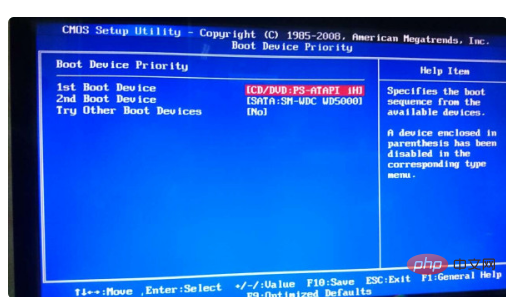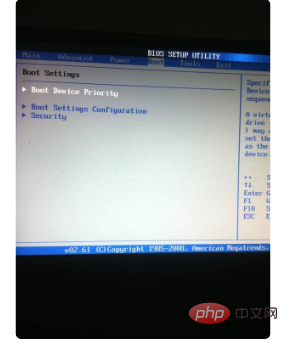 Operation and Maintenance
Operation and Maintenance
 Windows Operation and Maintenance
Windows Operation and Maintenance
 What should I do if the computer cannot be turned on and displays ctrl+alt+del?
What should I do if the computer cannot be turned on and displays ctrl+alt+del?
What should I do if the computer cannot be turned on and displays ctrl+alt+del?

What should I do if the computer cannot be turned on and displays ctrl alt del?
When the computer starts up, it displays PRESS CRTL ALT DEL TO RESTART and cannot enter the system. Based on past experience, it is probably caused by three reasons:
(First, shut down the computer and open the case. , reconnect the data cable of the hard disk and the power cable of the hard disk. This can eliminate the problem that the hard disk cannot be read due to poor contact and the English interface above appears.)
(1) Cause this One of the main reasons for the phenomenon is that there is an error in the master boot record (MBR) of the hard disk, so we must start by rebuilding the master boot record (MBR). The processing method is as follows:
First, prepare a GHOST with PE version of the latest installation CD, whether it is XP or WIN7 (generally you can buy one in software stores or computer stores for RMB 5-8) or prepare a USB boot disk with PE, then turn on the computer and press the F12 key or press the DEL to enter the BIOS, set the first boot item to the optical drive (or U disk), insert the CD (or insert the U disk), enter the CD (or U disk), enter WINPE, and find a software called diskgenius , open this software, find the "hard disk" of the host, select the hard disk, right-click, a drop-down box will pop up, and there will be a "Rebuild Master Boot Record (MBR)" on it, click this "Rebuild Master Boot Record (MBR)" , then a dialog box will pop up, click "Yes", and then a "Task Completed Successfully" dialog box will pop up, click "OK", you can repair the master boot record. Then restart the computer, and the computer will be able to enter the operating system. (As shown below)

(2) Another reason is: the first startup item of the motherboard BIOS is not set properly (usually set to the optical drive and hard disk), which will also cause As a result, the system cannot be booted, and the above English screen appears.
Processing method: Under normal circumstances, this is how it is handled, because motherboards are divided into two categories,
The first category is Award 6.0 type motherboards: This is how it is set: When the computer just starts Finally: Press the "DEL" key or the "Delete" key without letting go (of course, some computers also install ESC, F1, F2, F4, F11, but most computers install DELETE.) until the BIOS setting window appears, and then use Arrow keys, find "Advanced BIOS Features---BOOT Device Priority---1St BOOT Device (1ST FLOPPY DRIVE represents floppy drive SATA: SM-WDC WD5000 represents hard disk CD/DVD: PS-ATAPI IH represents optical drive) Just press here ENTER Select CD/DVD or SATA, and then press F10. The E-text dialog box will appear. Press the "Y" key (can be omitted) and press Enter. The computer will automatically restart, proving that the changed settings have taken effect. Generally, this setting will suffice. Enter the system.

The second type of AMI 8.0 motherboard is set like this: when the computer has just started, press and hold the DEL key (some computers Press F1, F2, F4, F11, ESC (but the most commonly used one is DELETE) until the BIOS setting window appears, and then use the arrow keys to find BOOT----boot settings---boot device priority--enter( OK)--1ST BOOT DEVICE---DVD/CD ROM (SATA: SM-WDC WD5000)--enter(OK)) and then press F10. After selecting the startup method, press F10, and the E-text dialog box will appear. , press the "Y" key (can be omitted) and press Enter. The computer will automatically restart, proving that the changed settings have taken effect. Generally, you can enter the system with this setting.

(3) If you have tried the above two methods and still cannot enter the system, and this screen appears, the only possibility is that the system file is damaged or lost, resulting in the system being unable to boot. In this case, you can only restore it with one click or Use a CD or USB flash drive to reinstall the system.
The above is the detailed content of What should I do if the computer cannot be turned on and displays ctrl+alt+del?. For more information, please follow other related articles on the PHP Chinese website!

Hot AI Tools

Undresser.AI Undress
AI-powered app for creating realistic nude photos

AI Clothes Remover
Online AI tool for removing clothes from photos.

Undress AI Tool
Undress images for free

Clothoff.io
AI clothes remover

Video Face Swap
Swap faces in any video effortlessly with our completely free AI face swap tool!

Hot Article

Hot Tools

Notepad++7.3.1
Easy-to-use and free code editor

SublimeText3 Chinese version
Chinese version, very easy to use

Zend Studio 13.0.1
Powerful PHP integrated development environment

Dreamweaver CS6
Visual web development tools

SublimeText3 Mac version
God-level code editing software (SublimeText3)

Hot Topics
 1663
1663
 14
14
 1420
1420
 52
52
 1315
1315
 25
25
 1266
1266
 29
29
 1239
1239
 24
24
 What is the reason why PS keeps showing loading?
Apr 06, 2025 pm 06:39 PM
What is the reason why PS keeps showing loading?
Apr 06, 2025 pm 06:39 PM
PS "Loading" problems are caused by resource access or processing problems: hard disk reading speed is slow or bad: Use CrystalDiskInfo to check the hard disk health and replace the problematic hard disk. Insufficient memory: Upgrade memory to meet PS's needs for high-resolution images and complex layer processing. Graphics card drivers are outdated or corrupted: Update the drivers to optimize communication between the PS and the graphics card. File paths are too long or file names have special characters: use short paths and avoid special characters. PS's own problem: Reinstall or repair the PS installer.
 How to speed up the loading speed of PS?
Apr 06, 2025 pm 06:27 PM
How to speed up the loading speed of PS?
Apr 06, 2025 pm 06:27 PM
Solving the problem of slow Photoshop startup requires a multi-pronged approach, including: upgrading hardware (memory, solid-state drive, CPU); uninstalling outdated or incompatible plug-ins; cleaning up system garbage and excessive background programs regularly; closing irrelevant programs with caution; avoiding opening a large number of files during startup.
 How to solve the problem of loading when PS is always showing that it is loading?
Apr 06, 2025 pm 06:30 PM
How to solve the problem of loading when PS is always showing that it is loading?
Apr 06, 2025 pm 06:30 PM
PS card is "Loading"? Solutions include: checking the computer configuration (memory, hard disk, processor), cleaning hard disk fragmentation, updating the graphics card driver, adjusting PS settings, reinstalling PS, and developing good programming habits.
 Is slow PS loading related to computer configuration?
Apr 06, 2025 pm 06:24 PM
Is slow PS loading related to computer configuration?
Apr 06, 2025 pm 06:24 PM
The reason for slow PS loading is the combined impact of hardware (CPU, memory, hard disk, graphics card) and software (system, background program). Solutions include: upgrading hardware (especially replacing solid-state drives), optimizing software (cleaning up system garbage, updating drivers, checking PS settings), and processing PS files. Regular computer maintenance can also help improve PS running speed.
 Does mysql need the internet
Apr 08, 2025 pm 02:18 PM
Does mysql need the internet
Apr 08, 2025 pm 02:18 PM
MySQL can run without network connections for basic data storage and management. However, network connection is required for interaction with other systems, remote access, or using advanced features such as replication and clustering. Additionally, security measures (such as firewalls), performance optimization (choose the right network connection), and data backup are critical to connecting to the Internet.
 Is PS slow loading related to other programs that are running?
Apr 06, 2025 pm 06:03 PM
Is PS slow loading related to other programs that are running?
Apr 06, 2025 pm 06:03 PM
The secrets to mastering Office software include: understanding different versions and platforms, correctly installing and configuring, proficient in using the software interface, in-depth understanding of feature operations, application collaboration and sharing functions, utilizing templates and styles, mastering advanced skills, and solving common problems. In addition, you need to choose a version that suits your needs, make good use of templates and styles, develop backup habits, and learn shortcut keys and advanced techniques to improve efficiency.
 How to solve the problem of loading when the PS opens the file?
Apr 06, 2025 pm 06:33 PM
How to solve the problem of loading when the PS opens the file?
Apr 06, 2025 pm 06:33 PM
"Loading" stuttering occurs when opening a file on PS. The reasons may include: too large or corrupted file, insufficient memory, slow hard disk speed, graphics card driver problems, PS version or plug-in conflicts. The solutions are: check file size and integrity, increase memory, upgrade hard disk, update graphics card driver, uninstall or disable suspicious plug-ins, and reinstall PS. This problem can be effectively solved by gradually checking and making good use of PS performance settings and developing good file management habits.
 Can mysql run on Windows
Apr 08, 2025 pm 01:54 PM
Can mysql run on Windows
Apr 08, 2025 pm 01:54 PM
Running MySQL on Windows is feasible, but challenges such as port conflicts, permission issues, and environment variable settings need to be considered. Installation issues can be solved by customizing configuration files, adjusting user permissions, and setting environment variables correctly. Additionally, the appropriate storage engine should be selected, tweaked configuration files, and SSDs should be used to optimize performance.



